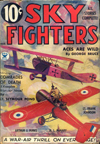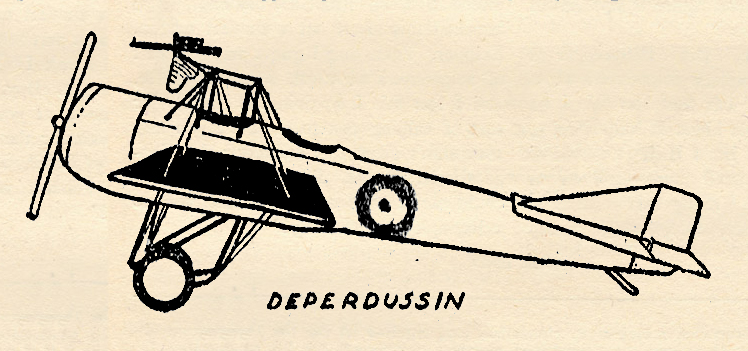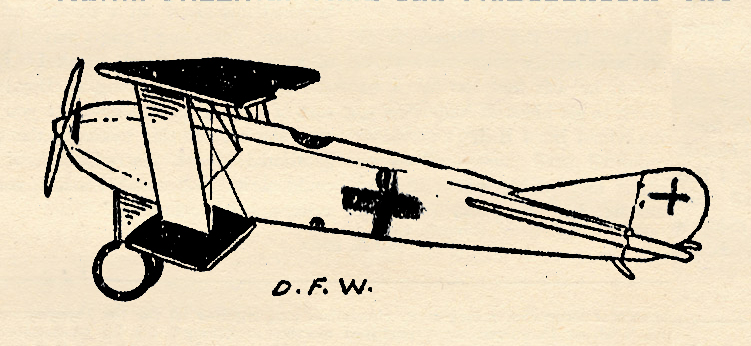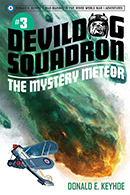“Sky Fighters, March 1935″ by Eugene M. Frandzen
Eugene M. Frandzen painted the covers of Sky Fighters from its first issue in 1932 until he moved on from the pulps in 1939. At this point in the run, the covers were about the planes featured on the cover more than the story depicted. On the March 1935 cover, It’s a battle of the French Deperdussin vs. the German D.F.W.!
The Ships on the Cover
FOR the gunner in the  front pit of the French Deperdussin of 1914-15, take off your hat and cheer lustily. Because that gentleman teetering behind the swirling prop makes the man on the flying trapeze look like a grandmother in a broadbeamed rocking chair.
front pit of the French Deperdussin of 1914-15, take off your hat and cheer lustily. Because that gentleman teetering behind the swirling prop makes the man on the flying trapeze look like a grandmother in a broadbeamed rocking chair.
For the German in the D.F.W. (Deutsche Flugzeug Werke) you can send out a powerful thought wave of sympathy. Possibly he has a Luger on his person, but it would be mighty ineffective against the barrage being sprayed from the muzzle of the Deperdussin’s Lewis gun.
The War Lords Snorted!
In the early war days when airmen of opposing sides waved friendly greetings to each other, machine-guns shooting in the direction in which the plane traveled were not thought of, at least not seriously. In fact the airplane was not taken very seriously. It staggered off the ground with its feeble motor churning the prop. It managed to stay up in the air for a fair length of time, but it was a fragile thing, given to falling apart at most inopportune moments. The war lords snorted when the air enthusiasts suggested that the airplane might some day become a major arm of defense and offense.
Not Exactly the McCoy, But—
“We’ll not live to see that day,” pompously said the brass hats. And they brushed aside all thoughts of these newfangled air toys. They concentrated on the cavalry, deeper dugouts and plain and fancy trenches. Then along came a few planes with machine-guns in the back pit, a pusher or two lumbered along with a front gun. Those planes with the most effective armament were capable of conquering or evading the opponents’ airmen and flew right over those brand new trenches and fancy dugouts. They were able to direct their artillery fire so effectively that the trenches and dugouts were very quickly obliterated.
About this time the reversal of feeling towards aircraft was complete. Any and all kinds of planes were thrown together and flung into the air. One way and another was tried to shoot forward. The Deperdussin system was one of France’s early efforts, and although it was not exactly the McCoy it was, for its time, a real step forward.

Although the D.F.W. has no front gun it has features of stability, speed and power which the French monoplane lacks. This type of D.F.W. at the beginning of the war had shattered all existing cross country flights. It was designed by Cecil Kny and was Germany’s first full streamlined plane. The strut bracing between the fuselage and the upper wing is practically the same as the famous Sopwith one and one-half strutter. The covering of the in-terplane struts and the undercarriage struts were helpful evidently in appearance only, because later models of this ship left the struts exposed.
Aviation in War Is Established!
The wing bracing of the Deperdussin seems complicated but today some of the small monoplane jobs use about the same stunt. Lateral control of the Deperdussin was obtained by warping the wing tips, which, of course is not as effective as aileron control.

Being speedier than the Deperdussin, the German D.F.W.’s pilot flipped his ailerons and barged out of the Frenchman’s range. He took home a riddled plane and a report which drove the German designers of front gun fire ahead at fever pitch. Nothing stood still during the war and it was not long before other ways of lead spraying appeared. Aviation in war was definitely established; a thing of power and effectiveness with which future wars will not only be fought, but be won.





